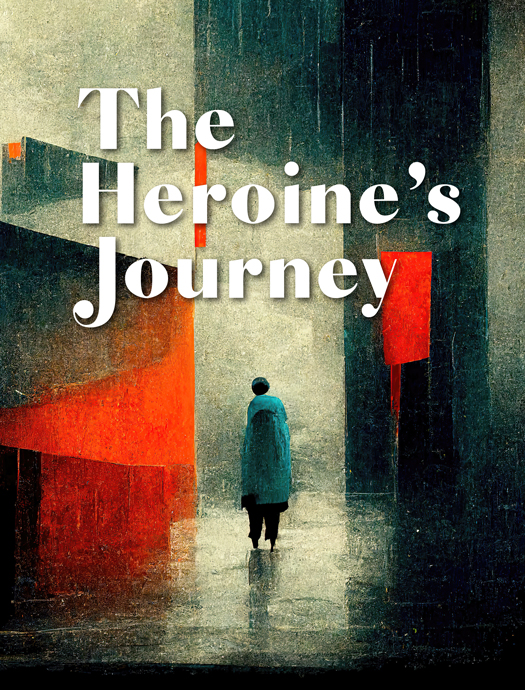By Kandace Hawley
I assume that you’ve heard of the Hero’s Journey. If you haven’t, a quick trip through Wikipedia will get you up to speed quite nicely. Joseph Campbell in his remarkable book A Hero with a Thousand Faces unearthed a common thread throughout our stories and myths, that of the Hero and their journey through spiritual death, transformation and rebirth.
Namely, in our stories, we have a central figure, the hero who leaves home, ventures into the unknown, faces trials and tribulations, gains victory against all odds, and returns home renewed. This is a story arc that we can see in the vast majority of our books, movies, games, myths, and fairy tales. It’s a common thread that reveals psychological truths about the journey of life and spiritual growth.
However, running parallel to the Hero’s Journey is the Heroine’s Journey. I think of both journeys as two sides of a single coin. They look similar and they represent journeys of transformation and growth, but they have their respective distinctions. Namely, the masculine Hero’s Journey* symbolizes how we grow by engaging with the external world. Whereas the Heroine’s Journey symbolizes how we grow by engaging with our internal world to reclaim and heal the lost symbolic feminine*.
In practice, the Heroine’s Journey is about healing ourselves in the deepest and most fundamental layers of our being. This requires less doing and more being, more feeling and less thinking, and more introspection and less external action. The Heroine’s Journey pulls your focus away from the external world so that you can feel into and explore your inner world. This sort of journey is depicted in stories like Alice in Wonderland and The Wizard of Oz, where both Alice and Dorothy are pulled away from their daily reality into an absurd dreamland, so that they may dethrone the evil queen or witch and regain their integrity.
But what does this process really look like? Well, think about it this way. You have a beautifully decorated house with a big basement. However, you don’t ever go down in this basement because it’s dark, scary and unknown. But as time passes, it’s more difficult to ignore this basement. Mold is creeping into the living room, the floors are unlevel, and there are strange noises crying out from the depths. To ignore all this is to risk the whole house and your sanity.
Yet at some point, whether it be by your own will or forced by circumstance, you finally go down to face what’s there. The first steps are the scariest, but as your flashlight illuminates each shelf and corner, you are humbled by what you see. You discover lost treasure from childhood, memories, and feelings long forgotten and condemned to darkness. You discover where things went wrong—how the floors are unlevel and how rot began to spread. You stay a while, exploring the depths, correcting what needs correcting and learning more about yourself in the process. Upon your return to the ground floor, you see that the floors are more level, there’s less mold, and there’s a bit more silence. And in your arms, you carry loads of reclaimed treasure.
In this analogy, your psyche is the house. The upper floors are your ego-consciousness (your conscious mind) and the basement is your unconscious, the symbolic underworld. The flashlight represents your awareness. And the beautiful décor of your house serves the purpose of masking neglected foundations, which are often untended psychic wounds that are left to fester in the depths. The spreading mold, unlevel floors, and noises are all the ways in which the psyche is screaming out for help and attention. In practice, these things could look like emotional triggers, neurosis, depression, anxiety, addiction, and even physical illness. They could even be recurring dreams and nightmares. The lost treasures are talents, gifts and aspects of your personality that for one reason or another were banished to the unconscious, often as a result of needing to fit in with friends and family growing up. In the beginning, the rest of the house and the basement are separate spaces. One condemned to darkness and the other is occupied and decorated. However, eventually the basement is integrated into the house, which represents the process of integrating our unconscious shadows into our personality.
What this analogy doesn’t describe is just how tough this process really is. One of the bravest things we can do is confront ourselves totally and honestly. During these past few years, the COVID-19 pandemic forced this journey on many of us because there wasn’t much that could be done outside of our own houses. But despite how tough it can be, the greatest gift of the Heroine’s Journey is to reconnect with our roots, our feelings, and our truth, so that when we return to the surface, we stand more grounded in our bodies, with planted feet and sturdy spines.
[NOTE]
*I use these terms masculine and feminine in the symbolic sense, because, as individuals, we all embody both symbolically masculine and feminine characteristics. Therefore, it doesn’t matter what sex or gender you happen to be, both journeys as available to you as psychological principles and symbols. You could easily replace these terms with yin and yang.
Kandace Sheri Hawley is an educator and writer who believes that every individual holds the key to their own truth. Her overall aim is to enable people on their own path to self-realization and discovery. She runs a podcast called “En Soma,” where she combines her academic background in education with her studies in Jungian Theory from GAP, along with her years of experience in analysis to share perspectives on spirituality, philosophy, society, and existence in general. You can find her at http://www.ensomapodcast.com.





